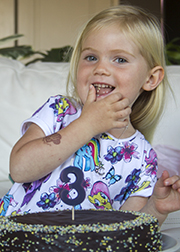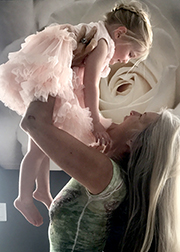
I find it challenging to keep current with Carly’s explosive development, three years and two months young and counting. Recall, 700 neurons per second, each connecting with thousands of others is the rate of brain growth the early years – 700 every second. Astonishing is the word I often use. Head turning.
Young children are said to be egocentric and I suppose Carly is, but no more than most adults I know. She has mastered two completely different languages and converses appropriately in each. She leaps high into the air and splashes laughing in the pool, unafraid. There is very little temper or whining. She states her wants and describes her preferences clearly and listens carefully when we have needs that need attending. Last evening, there was a lightning storm, somewhat rare in Southern California. She and I laid in the backyard staring up at the flashing clouds against the dark night sky. After a few moments she said, “I want to go inside,” and we did. Such fury is extreme for a three-year-old.
For the past few months I have been sharing how our hearts connect and sing together when we are close. “La, La, La,” I sing. “Can you feel it?” “Yes,” she says. Sometimes she sings too. Years ago Joseph Chilton Pearce described high school biology experiments where two heart cells, still pulsating, were placed on a glass microscope slide separated by a partition. At a certain proximity, but not physically touching, the two cells became entrained, pulsing together. “Imagine the energy being generated by millions or billions of heart cells,” Joe would say. What we call bonding is the entrained coherence of separate hearts resonating together, which is but one aspect of what Joe called the intelligence of the heart. “Come close,” I say to Carly, “my heart is singing.” She snuggles, her heart pressed next to mine, and we sit or lay quietly for a few moments. Sometimes for many moments. “La, La, La,” I whisper.
Children don’t ‘really’ want or need anything different from what we adults want; to be seen, understood and valued for who they are this moment, to feel safe, to be held, touched and played with care and appropriate affection, to be taken seriously and to have their feelings and needs respected; just the basics. Given this care, playful affection and respect, they will treat the world and everything in it just like that. The basics withheld, and they learn to cope and connive. Like Linus’ blanket in Peanuts or that ever-present binkie (pacifier), children are given counterfeits that mimic ‘the basics’ but they never satisfy the underlying hunger or need. Then, we grown-ups, addicted to our own pacifiers, get upset, frustrated and angry because our children are causing such a fuss.
What I find and have found astonishing throughout this adventure with Carly is how complete and whole she is and has been from the beginning, before birth and every step after. Each developmental stage is complete. If I think of her as half-baked, like a sticky pudding, that is how I will treat her. The assumptions that form my point of view is a paradigm, a way of seeing that forms my reality. For a long time it was assumed that the earth was flat. Then someone came along and demonstrated that it was round. The flat paradigm gave way to the round and the world changed. Seeing Carly and every child as whole and complete at every step and stage of their, and my, development is a paradigm shift and reality changes.
The compassionate heart responds with compassion to everything and every experience. The selfish heart is mean and often cruel by comparison. The question that every parent, educator, grandparent, preschool teacher, every coach, anyone who thinks they care about children should ask, and every day, is: how can I best awaken, nurture and deepen the compassionate heart. Obviously, this light must burn brightly inside before it can be seen by others outside. It is done onto us, and we do onto others, as we believe. What the compassionate heart believes about the world and others is fundamentally different from the selfish heart. Children become what they see and experience and that is how they treat the world.
At three Carly’s vocabulary is expanding like a runaway train. Past long ago were simple concepts like, ‘what’s that?’ Now it is why and spontaneous explanations. There is a near constant stream of words, descriptions and mini-stories. “This belongs right here,’ she says, and, “that works because of this…” I sat at the breakfast table and shared that our hearts are singing all the time creating an invisible field like a magnet. “Like the train,” said Carly. “Yes, can you bring the train and another car here?” I asked. She slipped from her tall chair and came running back with two original Brio trains with magnets on each end. “Look,” I said and I inched one of the train cars close to the other. Like Joe’s high school experiment, at a certain point the other car began to move and suddenly leaped and connected with the train in my hand. “This is how the song our hearts sing works. One heart can feel the other and at a certain point they sing the same song together.” Carly understood.
Storytelling is a song we sing with words. To read or, better still, to create and tell a spontaneous story organizes the energy that the heart and brain produce together. In the same way our Brio trains are connected by a magnetic field, storyteller and listener are connected by the field they share. Beneath the words is what physicist David Bohm called shared meaning. Meaning in this sense is a field, like a magnet, and our hearts and brain are influenced by that field. The heart senses and interprets the ever-changing meaning of the field directly, nonverbally. The abstracting brain centers, where symbols and metaphors roam, convert the heart’s direct perceptions into thought-images. The heart always comes first and by comparison the thinking brain is always catching up, pretending it knows. Attuning to the intelligence of the heart is what Carly and I share when our hearts sing together. As Joe shared so often, a brain cut off from this radiant attunement and meaning is lost, and a lost intellect is a very dangerous thing.
When I walk down the street and witness how misunderstood and therefore mistreated children often are, I weep inside. First, because the parent or adult is so lost in their dissociated patterns that they fail to see all the miracles their children see. They fail to experience the wonder and the mystery that abounds. They also fail to experience the joy, the energy and playfulness that children are by nature. I weep because failing to see and share this energy and playful wonder, the adult misunderstands who and what the child actually is. The adult world is so completely preoccupied with its adulterated and often myopic daydreams, the worries and the techno-media blitz, that they chronically abuse their child and don’t even notice. I weep for the children and for the adults equally. When all that is required is to wake up from the daydream and simply experience the beauty and the wonder this amazing experience bequests.
Story is the order of the day. Like clockwork, as Carly approached three something shifted. Everything now is a story. The ability to create mental images not present to the senses is the classic definition of imagination. Joe helped me understand how all higher development rests on this foundation. The more descriptive words Carly hears the greater this capacity grows, like an Olympic athlete. More on story next time.
We got a small box of wood track for Carly’s Brio train, twisting around and under bridges. Then, out came the forgotten basket of large Lego’s uncle Mark and aunt Sue shared months ago. There they lay in the basket, like the magic seeds in Jack in the Beanstalk, awaiting this moment to become a house next to the train tracks that Dr. Seuss would be proud of. Sharing the meaning of this creative moment, this new moment that will never come again, is all Carly really wants, to be seen for who she is right now as she morphs into something new right before our eyes. With this connection she is free to invest everything she has into fitting the next piece into place, with care and complete focused attention as I hand her a large blue Lego. “Thank you,” she says. “You are welcome!”
Michael

